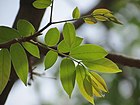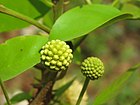Note: This is a project under development. The articles on this wiki are just being initiated and broadly incomplete. You can Help creating new pages.
Xylia xylocarpa
Xylia xylocarpa is a deciduous tree with a dense crown usually growing 20 - 40 metres tall. The bole is usually straight and cylindrical, sometimes with small buttresses. It can be unbranched for 12 metres or more and around 40 - 60cm in diameter.
Contents
- 1 Uses
- 2 Parts Used
- 3 Chemical Composition
- 4 Common names
- 5 Properties
- 6 Habit
- 7 Identification
- 8 List of Ayurvedic medicine in which the herb is used
- 9 Where to get the saplings
- 10 Mode of Propagation
- 11 How to plant/cultivate
- 12 Commonly seen growing in areas
- 13 Photo Gallery
- 14 References
- 15 External Links
Uses
Worms, Leprosy, Vomiting, Diarrhoea, Gonorrhoea, Ulcers, Rheumatism, Piles, Leprosy.[1]
Parts Used
Chemical Composition
It contains The mature seeds contained 29.5% crude protein, 14.78% crude fat, 8.02% crude fibre, 5.11% ash and 42.6% crude carbohydrates. The seeds appeared to be a good source of potassium, magnesium, phosphorus and iron.[2]
Common names
| Language | Common name |
|---|---|
| Kannada | ಬೆಟ್ಟದಾವರಿಕೆ ಮರ Bettadavarike mara, ಹೊನ್ನಾವರಿಕೆ Honnavarike |
| Hindi | Jambu, Jambu |
| Malayalam | Irula, Katamaram |
| Tamil | Iruvel |
| Telugu | Boja, Errachennangi |
| Marathi | Jambha, Suriya |
| Gujarathi | |
| Punjabi | |
| Kashmiri | |
| Sanskrit | Kanakakuli, Shinshapa |
| English | Burma Ironwood, Pyinkado |
.[3]
Properties
Reference: Dravya - Substance, Rasa - Taste, Guna - Qualities, Veerya - Potency, Vipaka - Post-digesion effect, Karma - Pharmacological activity, Prabhava - Therepeutics.
Dravya
Rasa
Guna
Veerya
Vipaka
Karma
Prabhava
Habit
Identification
Leaf
| Kind | Shape | Feature |
|---|---|---|
Flower
| Type | Size | Color and composition | Stamen | More information |
|---|---|---|---|---|
| Flowering from March to October |
Fruit
| Type | Size | Mass | Appearance | Seeds | More information |
|---|---|---|---|---|---|
| Fruiting from March to October |
Other features
List of Ayurvedic medicine in which the herb is used
Where to get the saplings
Mode of Propagation
How to plant/cultivate
A plant of the moist to wet lowland tropics, occasionally to elevations of 850 metres.[5]
Commonly seen growing in areas
Dry evergreen forest, Mixed deciduous forest, Dry deciduous dipterocarp forest, Higher altitude forests.
Photo Gallery
References
- ↑ Indian Medicinal Plants by C.P.Khare
- ↑ Chemical constituents
- ↑ Common names
- ↑ [Morphology]
- ↑ Cultivation
External Links
- Pages using duplicate arguments in template calls
- Ayurvedic Herbs known to be helpful to treat Worms
- Ayurvedic Herbs known to be helpful to treat Leprosy
- Ayurvedic Herbs known to be helpful to treat Vomiting
- Ayurvedic Herbs known to be helpful to treat Diarrhoea
- Ayurvedic Herbs known to be helpful to treat Gonorrhoea
- Ayurvedic Herbs known to be helpful to treat Ulcers
- Ayurvedic Herbs known to be helpful to treat Rheumatism
- Ayurvedic Herbs known to be helpful to treat Piles
- Herbs with Fruits used in medicine
- Herbs with Seeds used in medicine
- Herbs with common name in Kannada
- Herbs with common name in Hindi
- Herbs with common name in Malayalam
- Herbs with common name in Tamil
- Herbs with common name in Telugu
- Herbs with common name in Marathi
- Herbs with common name in Sanskrit
- Herbs with common name in English
- Habit - Tree
- Index of Plants which can be propagated by Seeds
- Herbs that are commonly seen in the region of Dry evergreen forest
- Herbs that are commonly seen in the region of Mixed deciduous forest
- Herbs that are commonly seen in the region of Dry deciduous dipterocarp forest
- Herbs that are commonly seen in the region of Higher altitude forests
- Herbs









